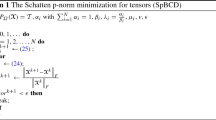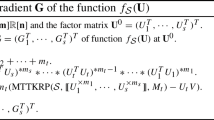Abstract
We study the problem of third-order tensor completion based on low CP rank recovery. Due to the NP-hardness of the calculation of CP rank, we propose an approximation method by using the sum of ranks of a few matrices as an upper bound of CP rank. We show that such upper bound is between CP rank and the square of CP rank of a tensor. This approximation would be useful when the CP rank is very small. Numerical algorithms are developed and examples are presented to demonstrate that the tensor completion performance by the proposed method is better than that of existing methods.




Similar content being viewed by others
Notes
Denote \(\mathbf {Y}=\sum _{\ell =1}^{I_1}m_{\ell j}\mathcal {A}(\ell ,:,:)\). Let the SVD of \(\mathbf {Y}\) be \(\mathbf {U}\varvec{\Sigma }\mathbf {V}^T\). The chain rule gives
$$\begin{aligned} \frac{\partial \mathscr {T}}{\partial \mathbf {M}}(i,j)=\bigg \{\text {tr}\left( (\mathbf {U}\mathbf {V}^T+\mathbf {W})^T \mathcal {A}(i,:,:)\right) : \mathbf {W}\in \mathbb {R}^{I_2\times I_3},\mathbf {U}^T\mathbf {W}=0,\mathbf {W}\mathbf {V}=0, \Vert \mathbf {W}\Vert _2\le 1 \bigg \}, \end{aligned}$$where \(\Vert \mathbf {W}\Vert _2\) is the spectral norm of \(\mathbf {W}\) and \(\text {tr}(\cdot )\) is the trace of a matrix.
The data are available at http://peterwonka.net/Publications/code/LRTC_Package_Ji.zip and have been used in [44].
The data are from BrainWeb [12] and available at http://brainweb.bic.mni.mcgill.ca/brainweb/selection_normal.html.
The data are from the video trace library [37] and available at http://trace.eas.asu.edu/yuv/.
To be more accurate, the slices that we utilize are submatrices of the unfolding matrix from the original tensor after some linear transform. See Corollary 2.6.
References
Ashraphijuo, M., Wang, X.: Fundamental conditions for low-CP-rank tensor completion. J. Mach. Learn. Res. 18(1), 2116–2145 (2017)
Attouch, H., Bolte, J., Redont, P., Soubeyran, A.: Proximal alternating minimization and projection methods for nonconvex problems: an approach based on the Kurdyka-Łojasiewicz inequality. Math. Oper. Res. 35(2), 438–457 (2010)
Bader, B.W., Kolda, T.G. et al.: MATLAB Tensor Toolbox Version 3.0-dev. https://www.tensortoolbox.org (2017)
Barak, B., Moitra, A.: Noisy tensor completion via the sum-of-squares hierarchy. In: Conference on Learning Theory, pp. 417–445 (2016)
Bolte, J., Sabach, S., Teboulle, M.: Proximal alternating linearized minimization for nonconvex and nonsmooth problems. Math. Program. 146(1–2), 459–494 (2014)
Boyd, S., Parikh, N., Chu, E., Peleato, B., Eckstein, J.: Distributed optimization and statistical learning via the alternating direction method of multipliers. Found. Trends® Mach. Learn. 3(1), 1–122 (2011)
Breiding, P., Vannieuwenhoven, N.: A Riemannian trust region method for the canonical tensor rank approximation problem. SIAM J. Optim. 28(3), 2435–2465 (2018)
Breiding, P., Vannieuwenhoven, N.: The condition number of join decompositions. SIAM J. Matrix Anal. Appl. 39(1), 287–309 (2018)
Cai, J.-F., Candès, E.J., Shen, Z.: A singular value thresholding algorithm for matrix completion. SIAM J. Optim. 20(4), 1956–1982 (2010)
Candès, E.J., Recht, B.: Exact matrix completion via convex optimization. Found. Comput. Math. 9(6), 717 (2009)
Candès, E.J., Tao, T.: The power of convex relaxation: near-optimal matrix completion. IEEE Trans. Inf. Theory 56(5), 2053–2080 (2010)
Cocosco, C.A., Kollokian, V., Kwan, R.K.-S., Pike, G.B., Evans, A.C.: Brainweb: Online interface to a 3D MRI simulated brain database. In NeuroImage, Citeseer (1997)
De Lathauwer, L., De Moor, B., Vandewalle, J.: A multilinear singular value decomposition. SIAM J. Matrix Anal. Appl. 21(4), 1253–1278 (2000)
De Silva, V., Lim, L.-H.: Tensor rank and the ill-posedness of the best low-rank approximation problem. SIAM J. Matrix Anal. Appl. 30(3), 1084–1127 (2008)
Edelman, A., Arias, T.A., Smith, S.T.: The geometry of algorithms with orthogonality constraints. SIAM J. Matrix Anal. Appl. 20(2), 303–353 (1998)
Friedland, S., Lim, L.-H.: Nuclear norm of higher-order tensors. Math. Comput. 87(311), 1255–1281 (2018)
Gandy, S., Recht, B., Yamada, I.: Tensor completion and low-n-rank tensor recovery via convex optimization. Inverse Prob. 27(2), 025010 (2011)
Goldfarb, D., Qin, Z.: Robust low-rank tensor recovery: models and algorithms. SIAM J. Matrix Anal. Appl. 35(1), 225–253 (2014)
Håstad, J.: Tensor rank is NP-complete. J. Algorithms 11(4), 644–654 (1990)
Hillar, C.J., Lim, L.-H.: Most tensor problems are NP-hard. J. ACM (JACM) 60(6), 45 (2013)
Holtz, S., Rohwedder, T., Schneider, R.: The alternating linear scheme for tensor optimization in the tensor train format. SIAM J. Sci. Comput. 34(2), A683–A713 (2012)
Horn, R.A., Johnson, C.R.: Matrix Analysis. Cambridge University Press, Cambridge (2012)
Jain, P., Oh, S.: Provable tensor factorization with missing data. In: Advances in Neural Information Processing Systems, pp. 1431–1439 (2014)
Jiang, B., Ma, S., Zhang, S.: Tensor principal component analysis via convex optimization. Math. Program. 150(2), 423–457 (2015)
Jiang, B., Ma, S., Zhang, S.: Low-M-rank tensor completion and robust tensor PCA. IEEE J. Sel. Top. Signal Process. 12(6), 1390–1404 (2018)
Jiang, B., Yang, F., Zhang, S.: Tensor and its Tucker core: the invariance relationships. Numer. Linear Algebra Appl. 24(3), e2086 (2017)
Jiang, Q., Ng, M.: Robust low-tubal-rank tensor completion via convex optimization. In: Proceedings of the Twenty-Eighth International Joint Conference on Artificial Intelligence, pp. 2649–2655 (2019)
Kilmer, M.E., Braman, K., Hao, N., Hoover, R.C.: Third-order tensors as operators on matrices: a theoretical and computational framework with applications in imaging. SIAM J. Matrix Anal. Appl. 34(1), 148–172 (2013)
Kolda, T.G., Bader, B.W.: Tensor decompositions and applications. SIAM Rev. 51(3), 455–500 (2009)
Kressner, D., Steinlechner, M., Vandereycken, B.: Low-rank tensor completion by Riemannian optimization. BIT Numer. Math. 54(2), 447–468 (2014)
Kruskal, J.B.: Three-way arrays: rank and uniqueness of trilinear decompositions, with application to arithmetic complexity and statistics. Linear Algebra Appl. 18(2), 95–138 (1977)
Landsberg, J.M.: Tensors: Geometry and Applications, vol. 128. American Mathematical Society, Providence (2012)
Liu, J., Musialski, P., Wonka, P., Ye, J.: Tensor completion for estimating missing values in visual data. IEEE Trans. Pattern Anal. Mach. Intell. 35(1), 208–220 (2013)
Mu, C., Huang, B., Wright, J., Goldfarb, D.: Square deal: lower bounds and improved relaxations for tensor recovery. In: International conference on machine learning, pp. 73–81 (2014)
Recht, B., Fazel, M., Parrilo, P.A.: Guaranteed minimum-rank solutions of linear matrix equations via nuclear norm minimization. SIAM Rev. 52(3), 471–501 (2010)
Rohwedder, T., Uschmajew, A.: On local convergence of alternating schemes for optimization of convex problems in the tensor train format. SIAM J. Numer. Anal. 51(2), 1134–1162 (2013)
Seeling, P., Reisslein, M.: Video transport evaluation with H. 264 video traces. IEEE Commun. Surv. Tutor. 14(4), 1142–1165 (2011)
Steinlechner, M.: Riemannian optimization for high-dimensional tensor completion. SIAM J. Sci. Comput. 38(5), S461–S484 (2016)
Uschmajew, A.: Local convergence of the alternating least squares algorithm for canonical tensor approximation. SIAM J. Matrix Anal. Appl. 33(2), 639–652 (2012)
Vannieuwenhoven, N.: Condition numbers for the tensor rank decomposition. Linear Algebra Appl. 535, 35–86 (2017)
Wen, Z., Yin, W.: A feasible method for optimization with orthogonality constraints. Math. Program. 142(1–2), 397–434 (2013)
Wen, Z., Yin, W., Zhang, Y.: Solving a low-rank factorization model for matrix completion by a nonlinear successive over-relaxation algorithm. Math. Program. Comput. 4(4), 333–361 (2012)
Wright, S.J.: Coordinate descent algorithms. Math. Program. 151(1), 3–34 (2015)
Xu, Y., Hao, R., Yin, W., Su, Z.: Parallel matrix factorization for low-rank tensor completion. Inverse Problems Imag. 9(2), 601–624 (2015)
Xu, Y., Yin, W.: A block coordinate descent method for regularized multiconvex optimization with applications to nonnegative tensor factorization and completion. SIAM J. Imag. Sci. 6(3), 1758–1789 (2013)
Yang, J., Yuan, X.: Linearized augmented Lagrangian and alternating direction methods for nuclear norm minimization. Math. Comput. 82(281), 301–329 (2013)
Yang, Y., Feng, Y., Huang, X., Suykens, J.A.: Rank-1 tensor properties with applications to a class of tensor optimization problems. SIAM J. Optim. 26(1), 171–196 (2016)
Yokota, T., Zhao, Q., Cichocki, A.: Smooth PARAFAC decomposition for tensor completion. IEEE Trans. Signal Process. 64(20), 5423–5436 (2016)
Yuan, M., Zhang, C.-H.: On tensor completion via nuclear norm minimization. Found. Comput. Math. 16(4), 1031–1068 (2016)
Zhang, Z., Aeron, S.: Exact tensor completion using t-SVD. IEEE Trans. Signal Process. 65(6), 1511–1526 (2017)
Zhao, Q., Zhang, L., Cichocki, A.: Bayesian CP factorization of incomplete tensors with automatic rank determination. IEEE Trans. Pattern Anal. Mach. Intell. 37(9), 1751–1763 (2015)
Acknowledgements
We are extremely grateful to two anonymous referees for their valuable feedback, which improved this paper significantly.
Author information
Authors and Affiliations
Corresponding author
Additional information
Publisher's Note
Springer Nature remains neutral with regard to jurisdictional claims in published maps and institutional affiliations.
T.-X. Jiang’s research is supported in part by the National Natural Science Foundation of China (12001446) and the Fundamental Research Funds for the Central Universities (JBK2102001). M. Ng’s research is supported in part by the HKRGC GRF 12306616, 12200317, 12300218 and 12300519, and HKU 104005583.
Rights and permissions
About this article
Cite this article
Zeng, C., Jiang, TX. & Ng , M.K. An approximation method of CP rank for third-order tensor completion. Numer. Math. 147, 727–757 (2021). https://doi.org/10.1007/s00211-021-01185-9
Received:
Revised:
Accepted:
Published:
Issue Date:
DOI: https://doi.org/10.1007/s00211-021-01185-9




